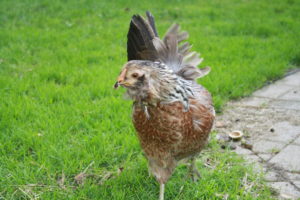
Little Miss Cross Beak chilling in her coop.
A crossed beak chicken?
Sadly it happens! Last year I received a dozen or so Easter Egger peeps from a mail-order company, they all seemed perfect at first. As the peeps grew over the first few weeks I noticed we had one small chick that grew at a much slower rate. However, after a closer look, it was clear there was something different with the little peep’s beak. There was a noticeable deformation that only grew worse as she grew. We officially had our first crossed beak chicken ever. Soon after came the realization that she needed a little extra help with feeding. She struggled to eat the little crumbles that her flock mates had no problem gobbling up.
So, I began to bring her out a few times a day to eat on her own with a wetted down version of the same food. To my surprise, it only took a bit of time and she began to grow and thrive just like the others. Little Cross Beak began to gain strength and acquire a loving personality. However, with an appearance all of her own, she was easily picked on by our large flock (at the time we had about 50 chickens). She was unable to peck them back and began escaping the pen daily following us around like a puppy. She eventually learned how to use her feet as little weapons against the others, helping to protect herself from harm. Now a year later we have found a few ways to make her life easier, she has become a bit spoiled.

Where ever I go, she goes, my sweet girl.
Signs
It is easy to identify a crossed beak chicken. The chicken’s beak will be crooked in such a way that the top and bottom do not meet up, instead they cross over each other. Sadly, this is becoming increasingly common amongst the chicken world.
Cause
A chick’s positioning during hatching in many cases causes the defect, especially if they do not have their wing over their head. The skull can become malformed which will reveal itself within the first few weeks of life as a crossed beak. There are also various nutritional deficiencies such as a lack of vitamin D, methionine, or calcium that can contribute to the deformation. A crossed beak can even be a genetic defect which is why many choose not to incubate eggs from a crossed beak chicken.
Outlook
The deformation can be fatal if the bird cannot eat and drink properly. However, most birds with crossed beaks can lead long, productive, and happy lives. Extra consideration at the feeder and waterer will be needed along with other accommodations.

Cross Beak’s Hampel Coop after adding the tractor conversion kit.
Accommodations
1. We changed her feed to a mash style rather than a crumble and added fruits, vegetables, and yogurt to her daily diet.
2. We trim her beak every few weeks to help combat against the drastic deformation.
3. She now shares a small coop with four retired Polish and Silkie hens. Now the largest bird in flock bullying is no longer an issue.
4. Also, the addition of a deeper water bowl helps her to drink.
5. Let out every morning into a run allows her to eat at the grass, bugs, fruits, and vegetables with ease.
6. We eventually transformed her coop into a chicken tractor to allow for fresh daily eating.













2 Comments
My cross beak Morticia is thriving since I started feeding baby bird formula. She is 8-9 weeks old. I also offer mash. I don’t know if she is getting enough mash between syringe feedings as she starts screaming when she’s hungry. She has a friend inside with her that is twice her size. Can you show me what you use to put food in. I’m currently using a raised cat dish for food and water. Thank you.
Thanks for a very informative article